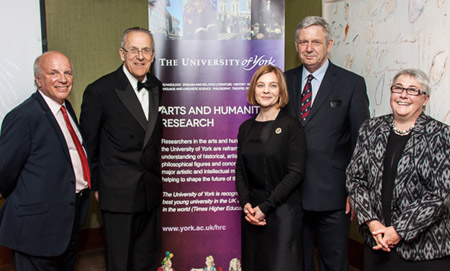Stateside spotlight on York's arts and humanities
Leading scholars showcased the University of York's research strengths in the arts and humanities at a series of events in the USA this week.

Greg Dyke, University Chancellor; Stephen Lash, Chairman Emeritus of Christie's Americas; Dr Kate Giles, Department of Archaeology; Dr Richard Shephard, Chamberlain of York Minster; and Sarah Brown, Department of History of Art. Photo by Richard D. Cole
At an event at Christie’s in New York to mark the University’s 50th Anniversary, archaeologist Dr Kate Giles and stained glass specialist Sarah Brown delivered a joint lecture titled: Preserving the Heavenly Jerusalem: Stone and Glass Conservation and Research at York Minster, the largest gothic cathedral in northern Europe.
It focused on the role the University is playing in both the restoration work the Great East Window of York Minster – the largest medieval stained glass window in the world – and the conservation of the Minster’s spectacular stone facade. The event was hosted jointly by the University, the Chamberlain of York Minster, Dr Richard Shephard, and Mr Hank Slack.
Dr Giles, of the University’s Department of Archaeology, is one of the UK’s leading buildings archaeologists and has developed a particular expertise on the archaeology of ‘public’ buildings in pre-modern England. As York Minster Archaeology Fellow, she is part of the ten-year programme to conserve and enhance understanding of archaeology and stone conservation of the East Front including the analysis of its weathering, historic mortars and coatings.
Sarah Brown, an internationally-leading conservator of stained glass, is course director of the University of York’s MA in Stained Glass Conservation and Heritage Management, which attracts students from all over the world. She combines this role in the Department of History of Art with her responsibilities as Director of the York Glaziers Trust will deliver a similar lecture at Columbia’s Avery Hall and NYU Institute of Fine Arts.
Researchers in the arts and humanities at York are reframing understandings of historical, artistic and philosophical figures and concepts, redefining major artistic and intellectual movements and helping to shape the future of our disciplines
Professor Mark Ormrod
A joint lecture by fellow University of York scholars - historian Professor Mark Ormrod and English scholar Professor Helen Fulton - drew on pioneering research at the University of York that questions cultural stereotypes about the British Isles in the later Middle Ages.
The lecture, which took place at both Columbia and NYU, showed that far from being isolated from continental Europe, the British Isles were in constant interaction with other peoples, events and trends in Europe and beyond.
Professor Ormrod, of the Department of History, drew on his major project 'England, Immigrants, 1330-1550', to show that English contact with foreigners was a reality in the age of the Hundred Years War, the Black Death and the Wars of the Roses. Professor Fulton, of the Department of English and Related Literature, built on her current work on the use of Middle English in Medieval Wales, and on the relationship between the British Isles and the Italian Renaissance, to explore cultural exchange within and beyond the British Isles in the age of Boccaccio and Chaucer.
Professor Ormrod, who is also the University’s Academic Co-ordinator for Arts and the Humanities, said: “Researchers in the arts and humanities at York are reframing understandings of historical, artistic and philosophical figures and concepts, redefining major artistic and intellectual movements and helping to shape the future of our disciplines. But we are also committed to taking the best of our research to communities beyond the academic environment in ambitious and productive ways and we therefore invite our research to engage positively with the contemporary world.
“Working in partnership with many voluntary and public organisations – including the British Museum, the Victoria and Albert Museum, York Museums Trust, Tate Britain and Tate Modern, the British Library, the Churches Conservation Trust, the National Centre for Early Music, English Heritage and the British Film Institute – we are able to share mutually enriching areas of expertise with highly trained professionals from the cultural industries and so find wider audiences for our work.”
In Washington DC, Jim Walvin, an Emeritus Professor in the Department of History at the University of York, lead a discussion titled: Looking at Slavery: Tarantino, Spielberg and the historians.
Further information
- The conference forms part of the University of York’s 50th Anniversary celebrations which are taking place around the world throughout 2013.
- Read more about preserving York Minster's Great East Window
- For more information about Arts and Humanities research at the University of York, visit www.york.ac.uk/hrc/
